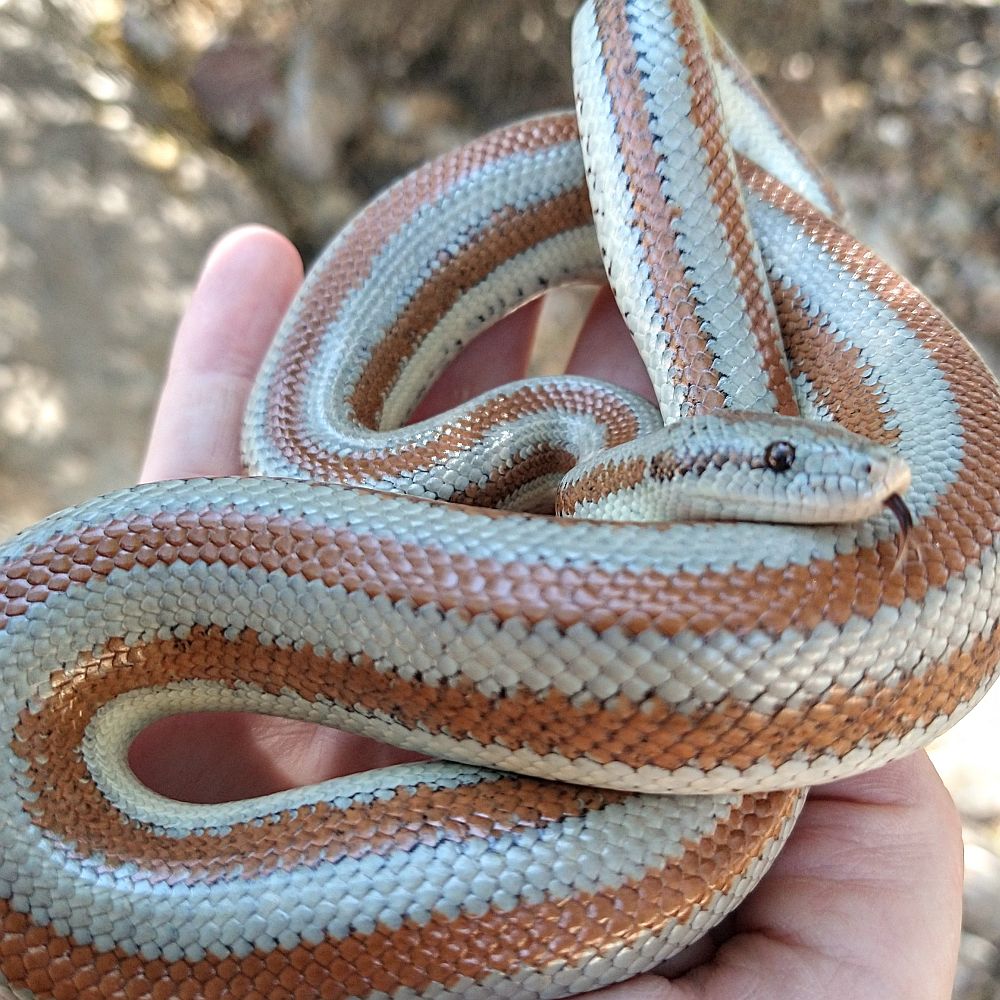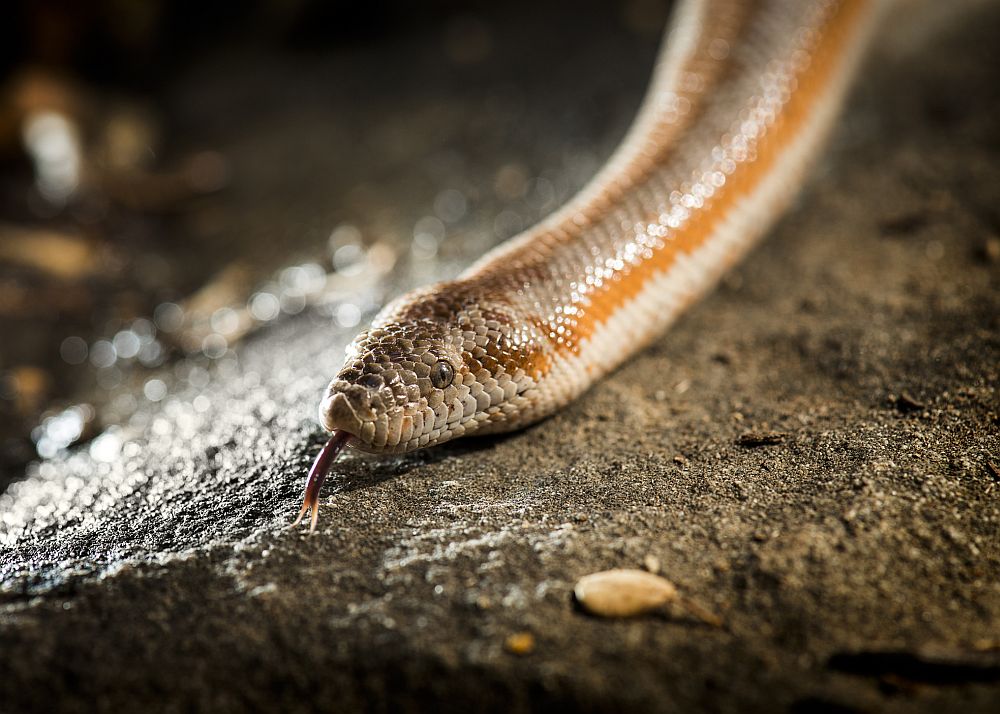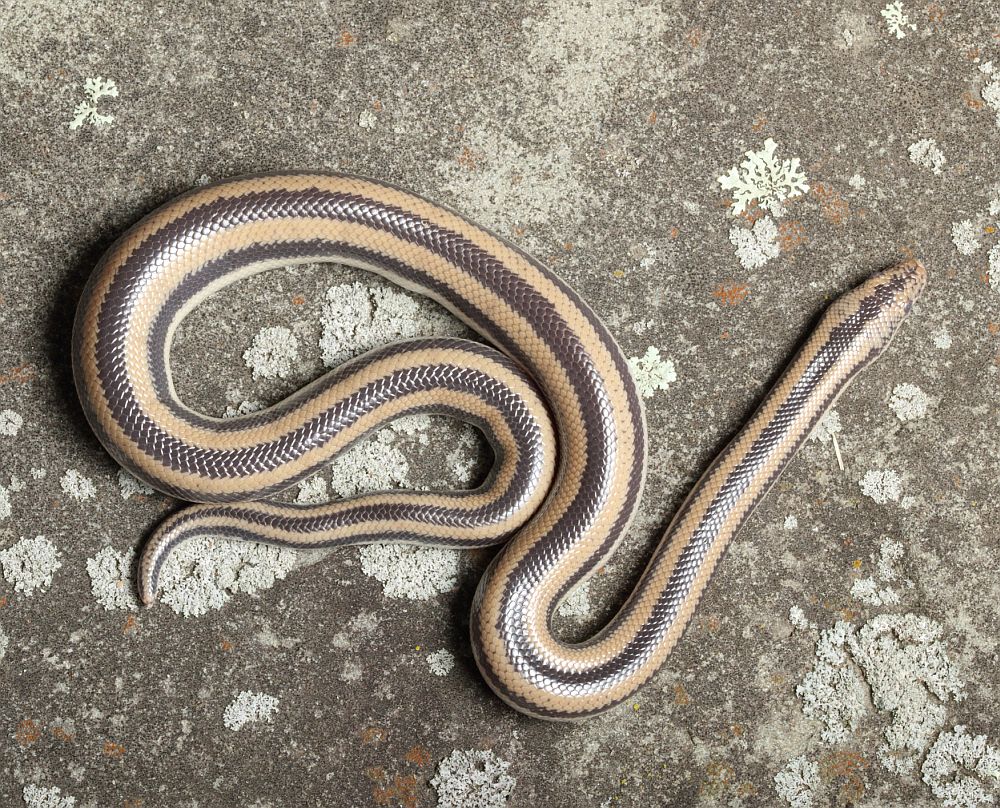The Rosy Boa is a beautiful snake that comes in a variety of patterns and colors. It’s a small, gentle snake that can almost always be handled without fear of being bitten, musked, or pooped on. This is why Rosy Boas are popular with both beginners and experienced snake keepers.
If you’re interested in learning more about Rosy Boa snakes, the proper size for their enclosure, and how to create a healthy and comfortable Rosy Boa habitat, we got you covered.

Quick Navigation
Are Rosy Boas Good Pets?
If your Rosy Boa feels threatened it might ball up and hide its head like a Ball Python, or it might release a nasty-smelling musk. But Rosy Boas are docile and slow-moving snakes that tolerate handling well, and rarely bite, which makes them a good first snake.
Rosies also have simple care requirements. They do not require specialized misting systems or hard-to-find prey items like chicks or small lizards. Their adult length of 1.5 to 3 feet means they can be kept in a 20 or 30-gallon tank. And because they are so easygoing, Rosy boas are one of the few snakes that can safely be kept two to a tank.
| SPECIES OVERVIEW | |
| Scientific name | Lichanura trivirgata |
| Common name | Rosy Boa, Three-Lined Boa, Rosie |
| Family | Boaidae |
| Size | 1.5-2 feet (males) 2.5-3.5 feet (females) |
| Life expectancy | 18-22 years, some Rosies live over 30 years |
| Tank size | 24 x 18 x 12 (males) 30 x 18 x 12 (females) Must be secure, as Rosy Boas are escape artists |
| Humidity | 20 to 40% |
| Temperature | Hot side 89-95F Cool side 75-80F |
| Feeding | Baby: pinky or hopper mice weekly Adult: adult mice or juvenile rats (every two weeks) |
Rosy Boa Housing Requirements

In the wild, Rosy Boas can be found in the deserts of southwestern America and northern Mexico. Because the desert is so hot, Rosy Boas spend the day in rock piles and outcroppings, coming out at dusk when the air is cooler. Your Rosy Boa habitat will need at least one and ideally several hides where it can feel safe against predators.
Their arid homeland also has extremely low humidity, so you need to keep an eye on your Rosy Boa’s environment to see that it does not get too damp. Rosy Boas will fare worse with too much water than with too little.
Rosy Boa Enclosure
A hatchling Rosy Boa will be very comfortable in a 10-gallon tank.
Male Rosy Boas will generally grow to between 18 inches and a bit over two feet, so you can keep most adult male Rosies in a 20-gallon tank.
Female Rosy Boas typically grow to 3 feet long and will be comfortable in a 30-gallon tank. A female Rosie can get up to nearly 4 feet, but that is rare.
You must always make sure that your enclosure is properly secured. Rosies are inquisitive snakes that are strong for their size. If there is any crack they can squeeze through, they will make their escape. You should avoid rough screen tops, as your Rosy Boa may rub its nose raw trying to get out.
Rosy Boa Substrate
Many keepers use newspaper or paper towels to line the bottom of their Rosy Boa’s habitat. While paper substrates are easy to clean and replace, they aren’t very attractive and they don’t give your Rosy Boa a chance to burrow.
A substrate of wood shavings can make your Rosie feel more secure, but make sure to avoid cedar, pine, or other aromatic wood shavings. You may get the best results with a specially formulated substrate like ZooMed’s ReptiSand. A depth of 1-2 inches will be easy to maintain with biweekly spot cleaning and bimonthly complete substrate changes.
Because Rosies are desert snakes that need low humidity requirements, avoid water-retaining substrates like coconut husk and soil.
Heating
Your Rosy Boa needs a temperature gradient that will allow it to choose between warmer and cooler areas. The best way to accomplish this is through heat tape or an under-tank heater that creates a space where your terrestrial Rosy Boas can bask. (Some keepers also include a basking lamp to give them an extra hot spot).
To make sure this warm spot is maintained, you will need a thermostat with an in-tank heat probe. These thermostats let you maintain a constant cage temperature and keep your Rosy Boa from becoming too warm or too cold.
The basking temperature on a Rosie’s warm side should be between 90 and 95 degrees, and the cool temperature should never get below 75.
Humidity
The humidity for a Rosy Boa habitat should never go above 40%. Putting a hygrometer inside lets you monitor the humidity and ensure your Rosie doesn’t suffer health issues from an overly damp home.
While most snakes will do best with fresh water available at all times, you should only put water in your Rosy Boa’s enclosure every three to four days. (Some keepers stretch that out to every three or four weeks).
When your Rosie is shedding, you can add another hide with some barely damp sphagnum moss. Your snake can slide through there to soften their old skin so it comes off in one piece.
What to Feed a Rosy Boa?
In the wild, Rosy Boas are opportunistic feeders that will eat just about anything that crosses their path. While their primary diet consists of rodents like mice and small rats, a wild Rosy Boa may also eat chicks, lizards, amphibians, and even other snakes!
Thankfully, in captivity, Rosy Boas will live happily on a diet of suitably sized frozen-thawed rodents. Very young Rosies start on pinky or hopper mice, while adult Rosies can take mice or juvenile rats. Put your frozen rodents in a bag, then soak the bag in hot water until the rodent is completely thawed and warm to the touch.
Common Rosy Boa Health Issues
Rosy Boas are generally hardy snakes, but there are some health issues you need to watch out for. Most of these health issues can be avoided simply by maintaining a proper habitat.

Respiratory Infections
Rosies with respiratory infections may:
- have mucus running from their nostrils
- be inactive
- go off their feed
- wheeze audibly
- hold their heads up with their mouths open as they try to get air
- make gurgling or clicking sounds
If you see these symptoms in your Rosy Boa, you will need to take them to a vet. Your veterinarian can determine whether your Rosie’s problems are caused by bacteria (the most frequent culprit), or by fungi, viruses, or parasites. A Rosy Boa vet can prescribe your Rosie the proper treatment.
Mites
If you notice your Rosy Boa soaking on the days you put in the water dish, it may be trying to relieve itching from snake mites. These tiny parasites hide in your Rosy Boa enclosure and feed off your snake’s blood.
If you see tiny black or red specks moving around your Rosy Boa’s eyes, near their cloaca, or under their chin, or if you notice mites moving in your habitat, you need to
- Move your Rosy Boa to a clean, empty Sterilite tub.
- Spray your Rosy Boa with a mite spray like Miracle Care Spray
- Remove all hides, rocks, and other items from your Rosy Boa habitat
- Throw out the substrate, wash your Rosy Boa enclosure thoroughly, and spray with mite spray
- Wash and spray all hides
- Add new substrate to Rosy Boa habitat, replace items, and return your snake to its home.
Check on your Rosy Boa daily and, if necessary, repeat the procedure every 4-5 days. This is stressful for your Rosy Boa and you, so you want to avoid mite issues if possible. You can do this by keeping your Rosy Boa enclosure clean and by keeping any new additions to your reptile collection safely quarantined away from your present herps until you are certain they have no mites, diseases, or parasites.
Scale or Mouth Rot
If your Rosy Boa habitat is too damp or too dirty, your Rosy Boa may come down with scale rot. “Scale rot” is a term used by snake keepers to describe any skin or scale infections or inflammation you see on your snake.
Damp substrate filled with snake feces is a breeding ground for bacteria that can infect your Rosy Boa’s skin. You will notice inflammation, cracked scales, and even abscesses. Scale rot most commonly starts on the belly scales but if left untreated can spread further. You may also see pus, swelling, and sores around your Rosy Boa’s mouth or mouth rot.
If you notice scale or mouth rot on your Rosy Boa, you can try a 20-minute soak in water with a bit of betadine added. If two soaks over a week do not cause the condition to clear up or improve noticeably, see a veterinarian.
Owning a Rosy Boa

So now that you’ve learned a bit more about Rosies, you think you want to buy one. You’ve made a good choice. Whether a Rosy Boa is your first snake or the latest addition to your collection, Rosies are beautiful, gentle snakes that are easy to keep.
So where do you go to find a Rosy Boa, and what should you be looking for?
Where to Buy a Rosy Boa
When you start looking for your snake, you will be much better off purchasing your Rosy Boa from a reputable breeder. While there are some excellent small independent pet stores, many larger pet stores sell sick snakes infested with mites and parasites.
You can find Rosy Boas for sale at Reptile Expos, where you can also meet other snake enthusiasts and learn more about Rosy Boa care. There are also several sites online where breeders often offer Rosy Boas for sale, including Kingsnake Classifieds and Morph Market.
Rosy Boa Morphs and Locales
When you start shopping for Rosy Boas, you will see people talking about “morphs” and also “locales.” A morph is a genetic mutation like albinism. A locale indicates the area from which the Rosy Boa (or its ancestors) was captured.
Some of the Rosy Boa morphs available include
- Albino: Albinism is a genetic mutation that suppresses the production of melanin. Albino Rosy Boas have yellow and orange stripes and red eyes.
- Axanthic: Axanthism reduces or eliminates the production of yellow and brown pigments. An Axanthic Rosy Boa has grey-black stripes on a light gunmetal background.
- Hypomelanistic: Hypomelanism reduces the production of brown and black while increasing the production of orange and red pigments.
- Snow: An Albino Axanthic Rosy Boa is called a Snow Rosy. Snow Rosies are solid white snakes with red eyes.
Rosy Boas are also sorted by locale. The major locality divisions are
- Mexican Rosy Boa: Mexican Rosy Boas usually have an off-white base color with three thick, dark grey-brown or black stripes running from their eyes to their tail tip.
- Desert Rosy Boa. Also called Morongo Valley Rosy Boas, these Rosies originate in southwest Arizona and southern California. They have a light brown or rosy pink color with a cream base.
- Coastal Rosy Boa: Coastal Rosies are the most variable locale. Some have orange stripes on a cream background while others have brown or red stripes against a blue-gray background. Coastal Boas are found on the Baja coastline in northwestern Mexico.
Rosy Boa (Lichanura trivirgata) FAQ
Are Rosy Boas venomous?
Rosy Boas are constrictors that kill their prey by suffocating it in their coils, not venomous snakes that inject their prey with toxins. Rosies are docile snakes that rarely bite, but even if you get nipped you’re in no danger.
Do Rosy Boas like being handled?
While no reptile actually enjoys being handled, Rosy Boas are docile snakes that will tolerate handling well without biting or musking. You should never handle your Rosie within 24 hours before it eats or 48 hours afterward, as it may regurgitate its meal.
Are Rosy Boas good for beginners?
Their beautiful coloration, docile temperament, modest size, and easy care requirements make Rosies an excellent choice for beginning snake keepers. So long as you keep their cage clean, dry, warm, and secure your Rosy Boa should thrive.
How much does a Rosy Boa cost?
A regular Rosy Boa will cost between $125 and $200, while some morphs and locales can cost as much as $400 or more. While you may be able to get a Rosy Boa for less at a chain pet store, you are more likely to get a healthy snake from a breeder online or at a reptile expo.
What do Rosy Boas eat in the wild?
The primary diet of Rosy Boas in the wild is rodents, mostly mice and small rats. But Rosy Boas are opportunistic feeders and have been known to eat chicks, small lizards, large beetles,
Are Rosy Boas slow?
Rosy Boas are among the slowest-moving snakes known to herpetology. In their native Southwestern desert, they spend most of their time resting in burrows and cracks and ambush their prey when it moves past them.
Where are Rosy Boas from?
Rosy Boas are found on Mexico’s Baja Peninsula and in the arid desert regions of the Southwestern United States. Rosy Boas are typically found in rocky areas where they sleep in crevices during the hot day and come out by dusk.
How long does a Rosy Boa live?
Rosy Boas are among the longest-lived snakes in captivity. An average Rosy Boa in captivity will live 18-22 years, but there are many reports of them living over 30 years and even a few unconfirmed reports of them living up to 50 years.
Are Rosy Boas endangered?
While it is currently listed as a Species of Least Concern by the IUCN, the ICUN also noted concerns with habitat fragmentation and declining numbers. In California the Rosy Boa is a strictly protected species and taking them from the wild is strictly forbidden.
How big a tank does a Rosy Boa need?
36 inches by 18 inches is a good Rosy Boa tank size for all but the very largest Rosy Boa females. Because Rosy Boas are terrestrial snakes, tank height is less important than length and width.
Conclusion
If you’re looking for a good first snake, a Rosy Boa is a great choice. As long as you can meet their basic care requirements, Rosies are easy to keep and forgiving of occasional slip-ups. Their slow-paced way of life not only means you don’t have to worry about getting bitten, but it also means you will have your Rosy Boa’s scaly companionship for years and maybe decades to come.